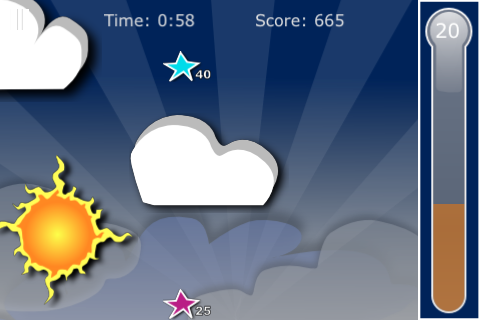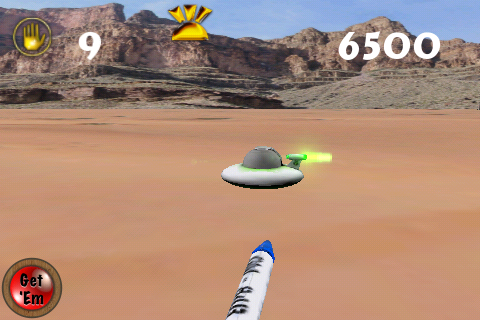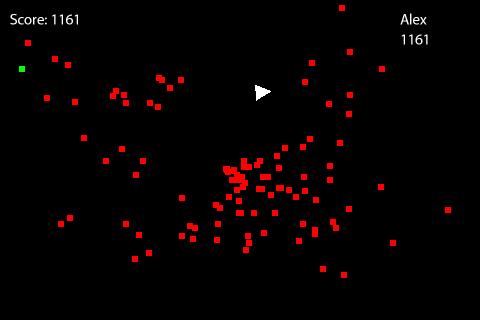Today we bring you an indie interview with Glenn Corpes, the creator of Ground Effect. You need to go get this game now if you do not already own it!
Company: Glenn Corpes
App Store: Ground Effect $2.99
How long have you been developing for the iPhone/iPod touch? What did you do before you started developing for the iPhone/iPod touch?
Just over a year, although I bought a mac and registered as a developer about a year and a half ago.
How long did it take you to develop Ground Effect and how many people were involved?
Almost a year, the team were:
Pam Douglas: a constant source of inspiration and sometime source of stress, by the time we had finished she had become quite an expert on the subtleties of the iPhone game market, I’m sure half of Ground Effect’s sales are because of her efforts.
Andrew Cakebread: Long time friend and programming colleague from 15 years ago at Bullfrog and several other places since. He did a couple of months work on the game in return for a copy of my library which he went on to use to develop Tilestorm and Eggbot’s Irish adventure.
Jack Corpes: My 15 year old son. Designed several of the levels and craft paint jobs and was the primary source of feedback in the early days of the project.
Mikey Corpes: His 13 year old brother. More paint jobs and level designs though his speciality turned ou to be the more evil levels later in the game.
Tartan Monkey: A highly talented artist with a day job. Hence the pseudonym.
Ben Carter: His name should probably be higher on the list but his work was done so long ago, he ported our library to the iPhone at around the time I registered as a dev. This really smoothed the transition to a new platform for me.
How did you come up with the idea for Ground Effect?
I worked on a game for the PC, original Playsation and Sega Saturn called Hi-Octane. About half way through it’s development time it was a great driving game but stopped being fun when the guns went in and the controls were dumbed down. I wanted to do a driving game that focused on that pure hover-racer with momentum feeling for 14 years. I also calculated that the iPhone would also be able to display a very detailed landscape, that had been an ongoing research project for almost a decade itself. The two ideas just came together
What inspired you for Ground Effect from initial concept to formalized game?
Just the fact that I was sure both ideas could come together on the iPhone. The idea was that it was relatively risk free and should have been possible fairly quickly.
What inspires you? And is it different for each game?
I have a background in 3D graphic technology. Most of the game ideas I have are based around a bit of technology, taking it in a hopefully fairly unique direction but keeping the game idea simple. I’m not into huge epic games myself, I much prefer games that take a simple idea and explore it.
What have you found most difficult about being an indie developer?
The responsibility and lack of support, the days wasted trying to get my head around the way photoshop handles alpha channels. The cutting and pasting bits of Objective C without taking the time to actually learn the language. Stuff like that.
Can you describe your development process?
That’s a big question. Ground Effect was built on a simple cross platform Library, my programming tasks were split between challenging technical problems to do with the graphic engine, boring formalised stuff to keep the cross-platform stuff working, the fun of actually tuning the handling system and the AI drones and the relatively mindless drudgery of the front end menu stuff. I sort of worked on which ever bits fitted my mood that day.
What does the creative process look like during the initial stages?
It started as a camera flying over a simple heightmapped mesh, multitexture was added, support for objects loaded from 3DS max, the level of detail (LOD) system. After a few months it was possible to fly a basic camera around a random rocky landscape.
Did you do any pre-marketing before Ground Effect was released?
We uploaded a couple of videos to Youtube and started threads on all of the iPhone game forums we could find. Only the Touch Arcade one got any attention. We managed to get articles on a few other iPhone gaming sites. Sadly this was all started a little too early as the game took a few more months to finish than we’d been hoping.
What are you working on now?
I’m working with Josh Presseisen (of Ravensword fame) on a completely different game based on some of the same tech. It’s a bit too early to say much about this yet but graphically, it’s going to be way beyond Ground Effect. I’m also doing contract work on a few console games.
Any plans for updates to Ground Effect?
Yes, we are working on new levels, these will be available in an update very soon.
What was your most frustrating task while developing Ground Effect?
The whole process was refreshingly painless. I guess if I did have to pick one thing it would be the time spent trying to get various little bits of Objective C to work but that was kind of my own fault for just jumping in without taking any time at all to learn the language. Also, switching back and forth from PC to mac took a while to become natural.
What have you found to be the most successful way to market Ground Effect?
We have been very impressed by the extra attention the game has been getting since we promoted it through www.freeappaday.com in early March. It really is all about people knowing your game exists and the half a million extra people who got to play it seem to be making that happen like nothing else has.
How much does user feedback affect your planning of updates and also future projects?
It’s a complex relationship. We had a lot of feedback from people demanding guns and to be able to update their craft but we also got a lot of people who clearly appreciated the game for what it is, a pure racing game. I personally believe that weapons ruin racing games, I could be wrong but I’ve stuck to it and Ground Effect will never have them. On the other hand, if people want weapons, big explosions and a hell of a lot more happening on the screen, they will not be disappointed in what is coming next. It isn’t a racing game though 🙂
Do you write games for yourself or for others? And why?
I find it completely soul destroying to work on a game that I don’t even like, I’ve done it enough times over the years. I believe that the only way to do it is to explore the areas of my own gaming taste that might actually appeal to others. My taste isn’t that weird…
What process do you go through to overcome creative block?
One of the advantages of doing so much of the development on my own is that when I didn’t feel inspired enough to work on a creative part of the game, there was always plenty of less exciting stuff or messing around in Photoshop to do. I was alwats too busy to ever get properly blocked.
Since its release what you do differently looking back?
I’d make it very clear that the first two levels are tutorials as it’s kind of depressing to see (via Openfeint stats) how many people never get past them and onto the levels with jumps, exploration and high speed banked turns.
What was the development atmosphere like? What kind of music did you listen to?
For a lot of the time it was kind of unhealthy, me at home, sat at a desk surrounded by 3 monitors for far too many hours at a time. Music was mostly my 24 hour super-playlist on random. The bands on this list with the most tracks are The Pixies, The Gang of Four, The Fall, The Cure. From that list it looks like I only like bands starting with “The”, there is a lot of other stuff honestly…
What was a must have during the development process of Ground Effect?
Not sure what you mean by this. Keeping the PC version going alongside the iPhone version was vital for debugging, it also would have been impossible to design levels without it. Away from the computer being able to get out on my Mountain bike or go skateboarding with my kids once in a while stopped me from growing to completely fill my chair…
What games influenced you in your decision to make Ground Effect?
It seemed to me that the iPhone was a platform where simplicity worked like no platform for a few decades. I thought a simple arcade style racer where the controls had been designed around the accelerometer and the graphic engine looked good (I knew I’d have a huge draw distance with a smooth frame rate at least) was bound to work. Of course it didn’t quite work out like this, a lot of customers wanted to know where the guns and upgrades were but you live and learn…
How close was the end product to your initial conceptualization?
Very close, almost exactly what I was hoping for.
Before the release of Ground Effect were there any huge last minute changes?
Very late in the testing phase one of the testers found you could get a better time by jabbing the boost button very quickly rather than long, well planned boosts. Fixing this was a complete nightmare and involved rewriting part of the code that had been fixed for many months. It also broke all of the AI opponents.
How did you keep yourself motivated?
Fear of the ever increasing quality of the apps released every day since I started the project.
How much did the art drive the game? The vision of what it was to look like how much of that was the driving force?
A lot of the look of the game is driven by algorithmically generated graphics. The islands are fractals, the tracks are extruded along a spline, the lighting, shadows and texturing of the level are done at load time by a few hundred lines of the most fun-to-write code in the game. The way the trails dissipate and fade is done with custom code. I’m mostly a graphics programmer with an ancient history as an artist (the last game I did the graphics for was Populous in ’87!) but I can’t claim it was all in my head at the start of the project. It doesn’t really work like that. It was in my head but the picture was very fuzzy, more of a potential picture based on experience and, I dunno, crossed fingers and hope maybe. I’m very pleased with how the final game looks though.
What tools of the trade are a must have for you when it comes to programming, art and music?
The code was done in a weird mix of XCode and Microsoft Visual Studio. Everyone who had any input into the art used Photoshop and the guy who designed the craft used 3DS max.
The music came from Pam talking to Diefenbach (the Danish band) and getting the instrumental version of a Rock in a Pond.
If you were stuck on an island with a laptop and no internet access what apps would you have loaded?
Autodesk Sketchbook
Google Earth
Weather Pro
PuzzleManiak
Fox vs Duck
Beatmaker
Geocaching
BeeJive IM (i’m assuming I can get a signal of course)
Tweetie 2
The Facebook app
:Shift:
Noiz2sa Free
Boost 3D
We want to thank Glenn for his time and can’t wait to see what comes next!





